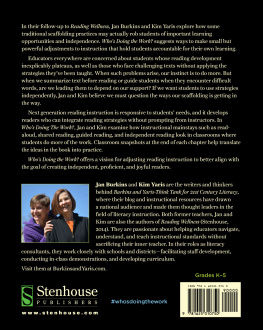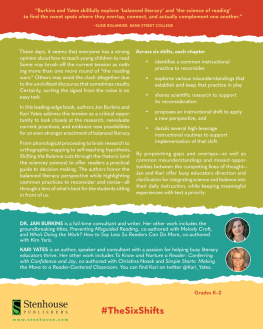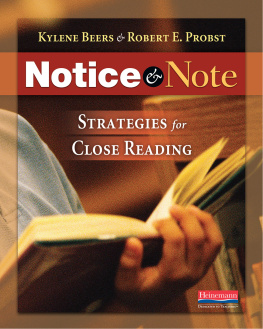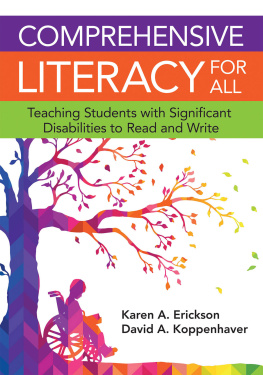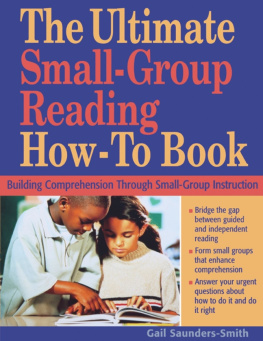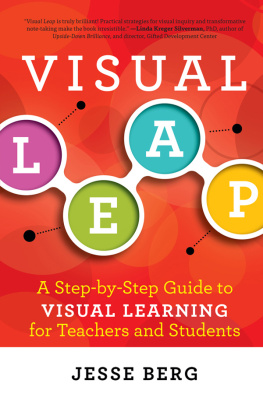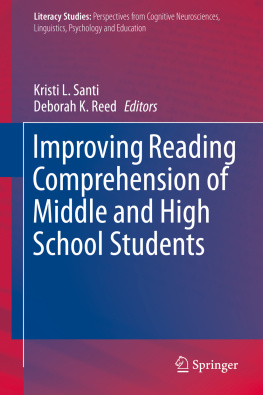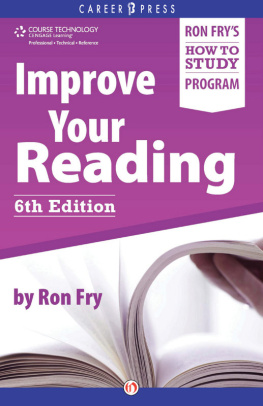Thank you for purchasing this Stenhouse e-book; we appreciate the opportunity to help you become an even more effective teacher. This e-book is for your own individual use: you may print one copy for your own personal use and you can access your e-book on multiple personal devices, including computers, e-readers, and smartphones. However, you cannot make print or digital copies to share with others, nor may you post this e-book on any server, website, or other digital or online system. If you would like permission to distribute or post sections of this e-book, please contact Stenhouse at permissions@stenhouse.com.
If you would like to see a full list of the e-books Stenhouse offers, please visit us at www.stenhouse/allebooks
WHOS DOING THE WORK?
WHOS DOING THE WORK?
HOW TO SAY LESS SO READERS CAN DO MORE
Jan Burkins and Kim Yaris
Foreword by Joan Moser of The 2 Sisters

|
|---|

| Stenhouse Publishers
www.stenhouse.com |
Copyright 2016 by Jan Burkins and Kim Yaris
All rights reserved. This e-book is intended for individual use only. You can print a copy for your own personal use and you can access this e-book on multiple personal devices (i.e. computer, e-reader, smartphone). You may not reproduce digital copies to share with others, post a digital copy on a server or a website, make photocopies for others, or transmit in any form by any other means, electronic or mechanical, without permission from the publisher.
Every effort has been made to contact copyright holders and students for permission to reproduce borrowed material. We regret any oversights that may have occurred and will be pleased to rectify them in subsequent reprints of the work.
Library of Congress Cataloging-in-Publication Data
Burkins, Jan Miller, and Yaris, Kim
Whos doing the work? : how to say less so your readers can do more
ISBN 9781625310750 (pbk. : alk. paper)ISBN 9781625310767 (ebook)
Cover and interior design by Lucian Burg, Lu Design Studios, Portland, ME www.ludesignstudios.com
Dedication

For Daisy
CONTENTS

Foreword

By Joan Moser
This is a book that needed to be writtenfor teachers, coaches, administrators, or anyone who cares about children of all ages.
I am returning to the sport of golf after a lengthy respite. Picking up clubs again brought back the familiar albeit frustrating feeling of learning something new. I was fortunate enough to find a golf coach skilled at assessing, diagnosing, and instructing everything from swing technique to course management. His coaching was so effective that, during our first meeting, I was hitting the ball akin to my golf days of the past. Alas, the success was short lived, for as soon as I ventured off without my trusty coach I was back to square one; even more concerning, all of a sudden I questioned whether or not I could ever golf successfully on my own.
Lamenting my poor play at our second meeting, I found that the lesson transpired differently. Each time I struck the ball poorly, I looked to Coach for swing-by-swing feedback, the suggestions and tips he had provided in the first session. But this time, each imploring look I gave was met with a smile and silence. I battled the frustration bubbling up within me as I asked him what I should do. He responded with four simple words, What could you try?
Those four words completely changed the outcome of the coaching session. They required me to pause and think about the strategies he had taught me. He was asking me to do the work of problem solving, rather than relying on him to do it for me. Red in the face, I had to admit I really had no idea what to do. Yes, I had taken the feedback he provided and put it into immediate action during our first lesson, but I was unable to replicate the strategies away from his coaching.
Immediately I recognized that I had come to rely on him to do the work for me and, as a result, put myself in a position of being utterly helpless. Simultaneously he indicated that he had changed his goal for me. Rather than to merely improve my game with his coaching, his new goal was for me to be able to problem solve, self-correct, and think through what I was doing on my own, away from him. In other words, to have me do the work first, followed by his selective and focused feedback.
By now you may be wondering how my golfing is connected to this book that needed to be written. As you may have figured out, my coach is also a teacher. We have had many conversations about everything from effective instructional techniques to guided practice. After our first few sessions together, our dialogues shifted to the many things we do as educators that are automatic, with little clear thought to their effectiveness. Some of these practices are hardwired into our DNA (for example, doing a summary of the text for students before reading, or preteaching vocabulary). For Coach, it meant he was hardwired to offer suggestions and tips after each and every one of my swings of the club.
Some of our teaching techniques may be a result of the education system over-correcting itself, going from one swing of the pendulum to the next. In some cases we may have participated in practices that, deep down, we knew were not in the best interest of students. (Consider the way we give children extremely hard text and assume that, with enough scaffolding, they will be able to read it.) In many recent cases these practices, whether hardwired or learned, appear to have been taken to the extreme. Teachers are being asked to do more and more talking, in the way of explaining, modeling, and instructing, while providing students even less time to do the actual reading and writing. When we function on autopilot, it becomes difficult to gain perspective or clearly reflect on our practices, which results in instruction that is less than effective.
Coach articulated that when he heard I didnt think I would ever be able to golf without him at my side, it surprised him into awareness. He became acutely conscious of the fact that he was teaching on autopilot rather than being mindful and reflective of what he had assessed as the specific needs of the person in front of him.
In their book Decisive: How to Make Better Choices in Life and Work (Crown Business, 2013), Chip and Dan Heath talk about a tripwire that can jolt people out of autopilot and into awareness. Coach and I talked about the need for educators to have this mechanismsomething to make us pause, step back, gain better perspective, and clearly reflect on our practices, all in the effort to course-correct and better meet the needs of our students.
I am delighted to say that the book you hold in your hands has been that tripwire for me. From its opening pages where you meet Daisy and her teacher, you will see the positive and negative power of the language we sometimes use with automaticity when working with students. Reading this book has provided the tripwire for some of the language and instructional practices I have used with students. I heard some of myself in Daisys well-intended teacher, and saw some of my own students who, like Daisy, became disengaged and dependent on me.
Next page
